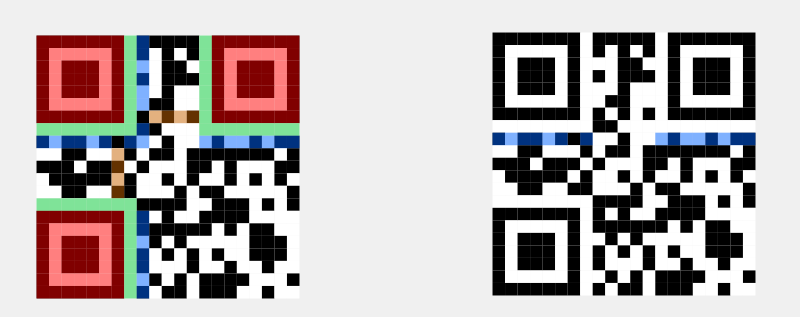Did you ever watch Star Wars and wondered how people understood what R2D2 was saying? Maybe [Luke Skywalker] would enjoy learning to decode QR Codes by hand, too. While it might not be very practical, it would be a good party trick — assuming, like us, you party with nerds.
You can start by scanning a code, or the site will create one according to your specifications or generate one randomly. It then takes the selected code and shows you how it is put together. Fun fact: 21×21 “modules” (QR-speak for pixels) is the size of a version 1 QR code. Each version increases the size by four modules.
You probably figured out already that the three big blocks in the corners are to help scanners find the code and orient themselves. There are also empty areas around the boxes that don’t count. Some versions of QR have additional patterns for alignment and timing bars that provide alternating bits.
As you might expect, other areas encode the format and error-correcting codes. However, one of the most important things is the mask. The mask pattern breaks up large areas of 1s or 0s. There are eight different masks, and since the goal is to do this all from memory, the site offers a helpful story about going to jail to help you memorize the different patterns. If you just can’t remember, they also offer you a foldable cheatsheet. Each black module in the mask inverts the QR code data.
Perhaps the hardest part is the actual reading, which zig-zags in two-column groups. You might also want an ASCII cheat sheet, although we are guessing that many people here can decode ASCII without much help.
If you want to tweak it or contribute, you can find the source code online. We thought this was an original idea, but, of course, it wasn’t. Once you can read QR codes by hand, you might as well make some by hand, too.















I dont need a computer, I use my phone :P
What? Your land line wall phone can read QR Codes? Oh, I bet your talking about those hand held devices some people now have… called a cell phone… I think? Kidding of course. Only time I’ve ‘had’ to use the cell phone for QR codes was work related to setup an RSA app for TFA.
In my youth (omg how that sounds!), these devices were being called “Mobilfunktelephon” (old spelling rules with Telephon vs Telefon; means mobile radio phone).
The predecessor was the “Autotelephon” (car telephone)..
Really? Around here, easily 9 out of 10 restaurants have a QR code instead of a menu.
Wow, that’s 9 out of 10 restaurants in your area that I would avoid out of principle. If I am REQUIRED to dick around with my phone, that’s not the kind of place I want to eat.
Phones are computers (technically humans are too)
thanks for explaining my joke to everyone who didnt get it
Possibly.
https://youtu.be/MJmBgKt4nKU
In Groland, there’s “Rubinion Ternieu” which is the last person that still make QR codes by hand:
https://www.youtube.com/watch?v=Hn4vKthXi3E
(use automatic translation ;)
Never thought I’d see Groland on Hackaday :)
“Perhaps the hardest part is the actual reading, which zig-zags in two-column groups. You might also want an ASCII cheat sheet, although we are guessing that many people here can decode ASCII without much help.”
Funny how accurate you are. 😃
Actually, I do have an ASCII chart in my purse.. 😁 It’s an CP437 chart, actually. That’s the original PC DOS codepage, a superset to 7-Bit ASCII.
Got the idea years ago when watching “The Martian”, I believe.
My father has a metal coin with morse code..
PS: Now that I think about it – having a little hex/binary chart would be cool, too. 😎
This fun page shows how robust QR codes can be:
Wounded QR code
http://www.datagenetics.com/blog/november12013/index.html
That’s awesome!
What? They didn’t try a tattoo?
Done that 5 to 10 years ago. The problem with decoding by hand is that you cannot use the redundant bits to recover damaged QR (the maths are a killer in this regard). Otherwise is … more fun to compute (Ja, Kraftwerk).
Also you can do the same with micro QR codes. They have only 3 sizes and very little info inside, so it won’t take long to decode or even encode them, but there are not to many phone readers out there.
Cognex barcode scanner can.
What’s funny though..
Back in the day we had the bar code, the one with the black/white stripes.
There were computer magazines in the 80s which tried to use it as an alternative to listings. The whole thing was very experimental.
That was in a time when cover disks were still to expensive to be included casually for each magazine issue.
Also, floppy disks were platform bound.
A simple bar code reader wasn’t. It was a simple photo transistor attached to a serial port. Or a parallel port in serial “mode”.
I remember the early “pen” barcode scanners, that you swiped across a barcode with your hand muscles. You had to keep an even speed, because if you sped up or slowed down during your swipe, the bits would be misinterpreted. Also you had to get the angle just right to get a good reflection into the sensor. 10/10 for cost saving minimal design, but I was sure happy when the “gun” type reader became available because the pen was a user unfriendly nightmare.
Cauzin Softstrip. Remember them well.
https://en.wikipedia.org/wiki/Cauzin_Softstrip
Anyone remember the CueCat
I didn’t so much wonder how they understood R2D2, but rather thought that they have droids that can speak, why did they make some of them only talk in beeps?
Chip shortage.
I got to mention, as something of a star wars nerd, they didn’t understand R2D2 for the most part, they relied on translators like C3PO or this builtin thing Luke had in his X-Wing.
Chewbacca, however… now that another story.